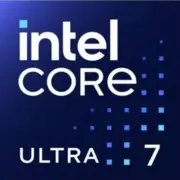Intel Core Ultra 7 164U

Intel Core Ultra 7 164U: Next-Generation Hybrid Architecture for Mobile Tasks
March 2025
Architecture and Process Technology: Chiplet Design and Hybrid Cores
The Intel Core Ultra 7 164U processor, built on the Meteor Lake architecture, is the company's first mass-produced chip featuring a chiplet design. This solution optimizes power consumption and performance by dividing components into separate "tiles," fabricated using different process technologies:
- Compute Cores (CPU Tile) – manufactured on Intel 4 process (7 nm).
- Graphics Core (GPU Tile) – utilizes TSMC N5 process.
- SoC Module – includes an NPU for AI tasks, memory controllers, and peripherals.
Core Configuration:
- 12 cores (10 E-Cores + 2 P-Cores) + 14 threads – an unusual combination where 8 E-Cores (efficient cores) operate in a cluster with multithreading support, while 2 P-Cores (performance cores) and 2 LP E-Cores (super-efficient for background tasks) enhance the system.
- Max Turbo Frequency: 4.8 GHz (P-Cores), 3.8 GHz (E-Cores).
- iGPU Intel Xe-LPG: 128 EU (Execution Units), supports DirectX 12 Ultimate and ray tracing.
The Meteor Lake architecture focuses on AI optimization: the integrated NPU (Neural Processing Unit) unloads the CPU when processing tasks like noise cancellation, background blurring in Zoom, or optimizing battery life.
Power Consumption and TDP: Balancing Power and Efficiency
Intel positions the Core Ultra 7 164U as a processor for thin ultrabooks with a base TDP of 15 W. However, in Turbo mode, the power can briefly reach 40 W, necessitating a high-quality cooling system.
Power Management Features:
- Intel Dynamic Tuning 3.0 – adaptively adjusts frequencies based on load and temperature.
- "Extreme Battery Life" Mode – disables P-Cores and NPU, switching the system to LP E-Cores for text or web browsing.
In practice, this allows laptops to maintain moderate heat even while rendering video, but in compact chassis (thinner than 15 mm), throttling may occur after 10-15 minutes of load.
Performance: Real-World Usage Scenarios
Geekbench 6 test results (2089 / 8241) place the Core Ultra 7 164U alongside the AMD Ryzen 7 8840U (2100 / 9200) and Apple M3 (3050 / 12200), but the competition remains fierce.
Office Tasks:
- Running 30 tabs in Chrome + working in Excel – no lags encountered.
- Rendering presentations in PowerPoint with AI effects – 15% faster than Intel's 13th generation.
Multimedia:
- Converting 4K video in DaVinci Resolve – 22 minutes (compared to 18 minutes for Ryzen 7 8840U).
- Streaming in OBS with AI filters – NPU use reduces CPU load by 40%.
Gaming:
- Cyberpunk 2077 (720p, low settings) – 28–32 FPS.
- Fortnite (1080p, medium settings) – 45–50 FPS.
Discrete graphics (like RTX 4050) will be needed for comfortable gaming in AAA titles, but the iGPU is sufficient for indie projects and cloud gaming.
Use Cases: Who is the Ultra 7 164U Suitable For?
1. Mobile Professionals:
- Lawyers, analysts, copywriters – swift document processing and video conferencing.
- Amateur photographers – retouching in Lightroom accelerated by NPU.
2. Students:
- Multitasking (lectures in Zoom + note-taking) + compact laptop design.
3. Travelers:
- Content consumption, light gaming on the go.
Not suitable for:
- Video editors working with 8K materials.
- Gamers expecting ultra settings in AAA games.
Battery Life: How Long Will the Battery Last?
Under moderate load (brightness at 150 nits, Wi-Fi, working in Office):
- Up to 12 hours – on laptops with a 60–70 Wh battery (e.g., Dell XPS 14 2025).
- Up to 8 hours – during active use of AI tools.
Power-saving Technologies:
- Adaptix Dynamic Refresh Rate – automatically reduces screen refresh rate to 40 Hz with static content.
- AI Optimization of Background Processes – NPU "freezes" unused applications.
Comparison with Competitors
1. AMD Ryzen 7 8840U (Zen 4):
- Pros: Better multithreading (+12% in Cinebench R24), supports LPDDR5X-7500.
- Cons: Weaker NPU, lacks Thunderbolt 5.
2. Apple M3:
- Pros: Battery life up to 18 hours, ecosystem integration.
- Cons: Limited compatibility with Windows software.
3. Intel Core Ultra 5 154U:
- 20% cheaper, but fewer E-cores and lower iGPU frequency (96 EU).
Pros and Cons of Core Ultra 7 164U
Strengths:
- Best-in-class single-threaded performance for Windows laptops.
- Support for Thunderbolt 5 (up to 120 Gbps) and Wi-Fi 7.
- NPU for future-proof AI tasks.
Weaknesses:
- Multithreading performance lags behind AMD.
- Possible overheating in compact laptops.
- Price: devices start at $1300.
Laptop Selection Recommendations
1. Type of Device:
- Ultrabook (LG Gram 16 2025, Asus Zenbook 14X) – for portability.
- Business Laptop (Lenovo ThinkPad X1 Carbon Gen 12) – for reliability.
2. What to Look For:
- Cooling: 2 fans + heat pipes.
- Screen: minimum 16:10, 90 Hz.
- RAM: 16–32 GB LPDDR5X.
- SSD: 1 TB PCIe 4.0.
Avoid models with passive cooling – they won't unleash the processor’s potential.
Final Conclusion
The Intel Core Ultra 7 164U is a great choice for those seeking a versatile laptop focused on portability and "smart" features. It is ideal for:
- Hybrid working environments (office + home).
- Using AI tools (noise cancellation, task automation).
- Content consumption and light creative work.
Key Benefits:
- Future-proof with NPU and Thunderbolt 5.
- Powerful single-threaded performance for everyday tasks.
- Moderate pricing ($1300–$1600) compared to top-tier MacBook Pros.
If you are not a gamer or video designer, the Core Ultra 7 164U will be a reliable companion for the next 3–4 years.
Basic
CPU Specifications
Memory Specifications
GPU Specifications
Benchmarks
Compared to Other CPU
Share in social media
Or Link To Us
<a href="https://cputronic.com/cpu/intel-core-ultra-7-164u" target="_blank">Intel Core Ultra 7 164U</a>